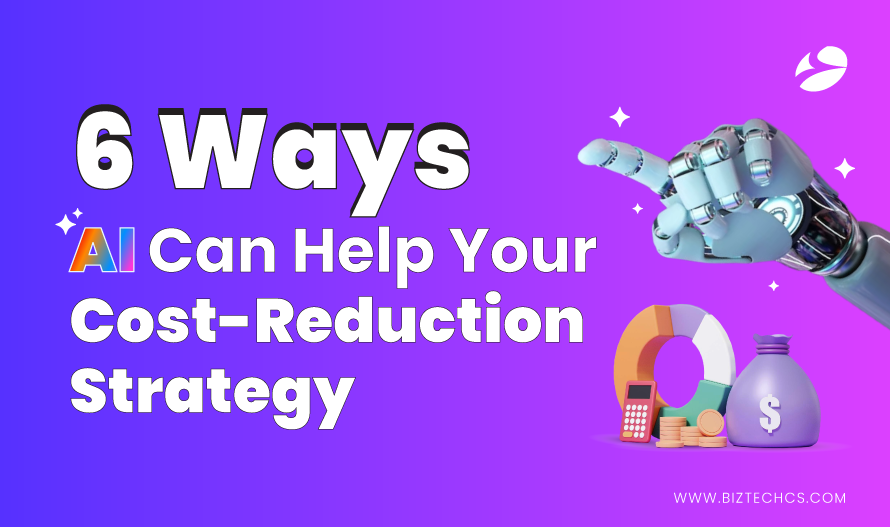6 Ways AI Can Help Your Cost-Reduction Strategy
11 Oct, 2024
5 min read
11 Oct, 2024
5 min read
Table of Content

Reducing costs has become even more important in the current world of economic competition. That’s where AI comes in to help with your cost-saving plans.
AI can also analyze spending patterns, identify the most efficient internal routes to reducing spending, and make cost-saving suggestions.
An AI consultant can help you decide which AI solutions should be implemented for your business. smart automation, with the help of multiple intelligence and predictive analysis, enables them to save money.
AI reduces costs and improves operations. Below are six aspects of how to utilize AI effectively to achieve high cost-saving goals.
AI has potential in the world economy and can help save money in several fields. It reduces workload, meaning that it cuts costs such as labor costs by performing repetitive tasks.
A chatbot, for instance, is cost-effective since it can address as many customers as possible within a short time.
McKinsey shared detailed statistics based on their AI poll of 1,000 firms, reporting cost savings of 20-30%. Looking at procurement and inventory also shows that the application of AI in powering such systems reduces wastage and excessive stock. Maintenance in manufacturing then anticipates equipment breakdowns and can reduce maintenance costs by about 40% (Deloitte).
In marketing, artificial intelligence helps define the target audience’s demographic in comparison to previous methods to place ads better, hence reducing advertising costs by up to 50%.
AI is applied for fraud recognition at financial organizations, where it results in a nearly 50% decrease in loss (PwC).
AI tightens structures and makes operational processes more efficient, ultimately achieving substantial cost reductions. This will continue as more organizations integrate artificial intelligence technologies.
AI, or Artificial Intelligence, is the ability to enable computers to make decisions in the same way humans do.
It employs data and patterns to solve problems or to do specific operations. AI can perform many tasks such as vision, speech, and even games can be made by AI.
This situation gets better with time, which involves correcting mistakes made in previous years. That is why AI is used in things like virtual assistants, chatbots, and self-driving cars.
1. Automation of Repetitive Tasks
AI is particularly suited for data entry, report generation, and even inventory keeping among others. It perform these tasks are much faster than humans; thus, it eliminates the time taken for such tasks. Automation minimizes on errors which are commonly associated with other manual processes. This leads to accurate collection of data, better organizational decisions and decisions avoiding wasteful costs on the other side. It also benefits businesses cost-wise by using far less, and takes pressure off employees allowing them to deal with more complicated matters.
2. Predictive Maintenance
AI is also useful in forecasting times that machinery or equipment is most likely to develop a fault. It studies data from sensors and previous breakdowns that analysed to find a similarity. He was able to note that this is made possible because businesses can identify issues early before they lead to inconveniences and expensive losses. It’s always cheaper to maintain a machine than repair it especially when the repair is emergent. Minimizing breakdown implies that operations will run smoothly, hence less time will be spent and less money will be spent on maintenance.
3. Enhanced Supply Chain Management
AI can monitor products’ availability, trends, and suppliers within the same period. This is useful in stock management, since one does not order huge quantities of products, or order products that are out of stock. It also determines the most suitable channels for shipment, thus cutting on transport expenses. In the case of demand fluctuation, through AI, companies achieve just the right level of supply to meet customer needs with little to no surplus. Supply chain management results to minimized cost within the operations and therefore increased profitability.
4. Dynamic Pricing Strategies
AI involves market trends analysis, customers purchasing behavior, competitors’ prices, among other aspects to determine the right pricing strategies. This makes it easier for businesses to change their prices and align them with the current market forces. It means that by adjusting the price, it is possible to gain more revenue and profit, but remain competitive on the market. It assist in making room for new products by clearing the inventory of old stocks and increase market share. It minimizes wastage through unsold stocks and tends to increase income.
5. Workforce Optimization
AI is also capable of predicting future occurrences and, therefore, determines the number of employees required for certain tasks at certain times. This is by identifying parameters such as traffic times, traffic characteristics, and months. This also assists in determining the optimum number of staff to be hired to ensure that unnecessary staff are not hired. By doing so, appropriate shift arrangements prevent the scenarios whereby businesses hire excess employees or lack sufficient workforce to meet their needs. It also ensures that employees are optimally utilised, which increases efficiency and consequently, prevents unnecessary costs.
Using AI for cost reduction offers several benefits:
1. Edge AI Computing
A future of edge AI computing is an emerging concept that decentralizes the computation from the server level to the end devices like phones, IoT apparatuses. This mode minimizes the data that you have to transfer to the cloud; this way it is cheaper and faster. In addition, edge AI also subtracts costs of infrastructure and energy consumption by employing low power devices. It also allows real-time processing, which is essential in applications, such as self-driving vehicles and smart residences. This approach of democratizing utilizes tremendous advancement and provides a cost-effective and effective solution for businesses and consumers.
2. Efficient Model Architectures and Training Techniques
One of the trends of the future is the creation of effective model structures and training that require low computing power. Transformers already demonstrated good performance with fewer computations and additional techniques such as pruning lead to a significant reduction in the model size with minimal impacts on its performance. These approaches enable training time to be reduced and need of expensive equipments which in the long-run brings down the costs greatly. The ability to fine-tune pre-existing models make it possible to deploy solutions much faster and with less resources than training models from scratch. This will also ensure that the costs of implementing AI is made less and therefore can be implemented by those organizations or companies which have a limited number of calculation powers.
3. AI Hardware Optimization
Another exciting area in AI is the emergence of AI-specific hardware, including GPUs, TPUs, and AI-oriented chips. Some of these hardware optimizations are for the purpose of enhancing the speed of training and inference in AI operations. They are more power-efficient than conventional computing devices, thus reducing costs considerably. This cost cutting means that the smaller business entity is able to incorporate the AI technologies that had hitherto been more costly. Thus, with more and more businesses adopting these optimized chips, one can predict that in the future AI will become cheaper and even more integrated than it is today.
4. Low-Code/No-Code AI Platforms
Low-code/no-code AI platforms are a growing trend that makes building AI models easier for non-experts. These tools allow people with little programming knowledge to create AI solutions, reducing the need for specialized developers. This shift lowers costs by making AI more accessible to businesses of all sizes. Companies can now integrate and maintain AI without investing heavily in technical expertise. As a result, AI adoption is becoming more affordable and widespread, driving future growth in various industries.
Incorporating AI into your cost-reduction strategy can transform the way your business operates. By automating tasks, improving decision-making, and enhancing efficiency, AI helps cut costs effectively.
Each of the six ways mentioned offers unique benefits tailored to different aspects of cost-saving.
From streamlining operations to optimizing resource usage, AI provides practical solutions. It’s an investment that pays off quickly and continues to deliver results.
If you’re looking for AI-powered development services to optimize cost reduction for your business, contact us today. We have a team of skilled AI & ML developers ready to help.
AI analyzes large sets of data to identify patterns in spending and inefficiencies, pointing out areas where costs can be cut. It helps automate routine processes, reducing the need for manual intervention.
AI streamlines operations by automating repetitive tasks, reducing errors, and speeding up processes. It optimizes resource allocation, ensuring minimal waste and lower costs.
AI assists in workforce management by predicting staffing needs based on demand, helping avoid overstaffing or understaffing. It can automate scheduling, leading to better use of employees’ time.
AI optimizes supply chain management by predicting demand and adjusting inventory levels accordingly. It also identifies the most cost-effective shipping routes and methods.

.NET
70
By Devik Gondaliya
15 Jul, 2025

.NET
66
By Devik Gondaliya
15 Jul, 2025

Odoo
121
By Biztech
15 Jul, 2025